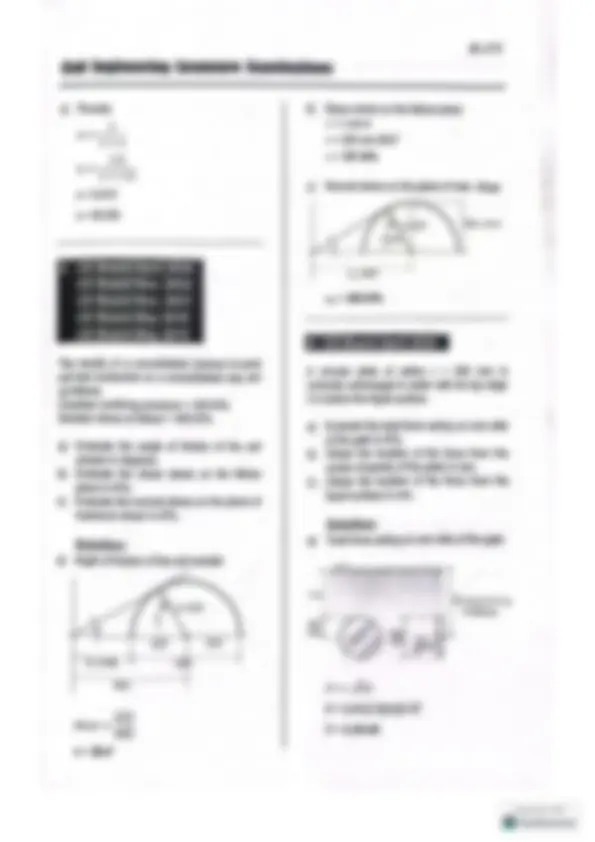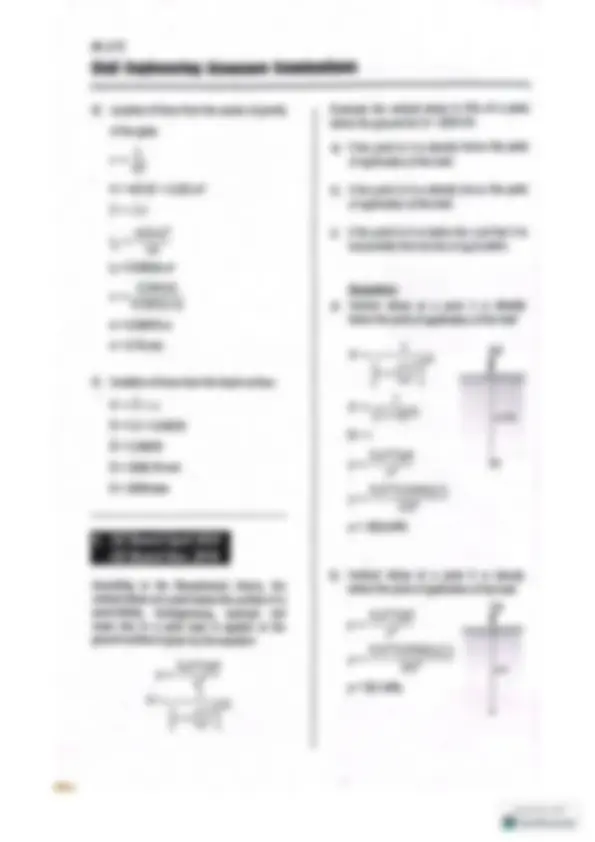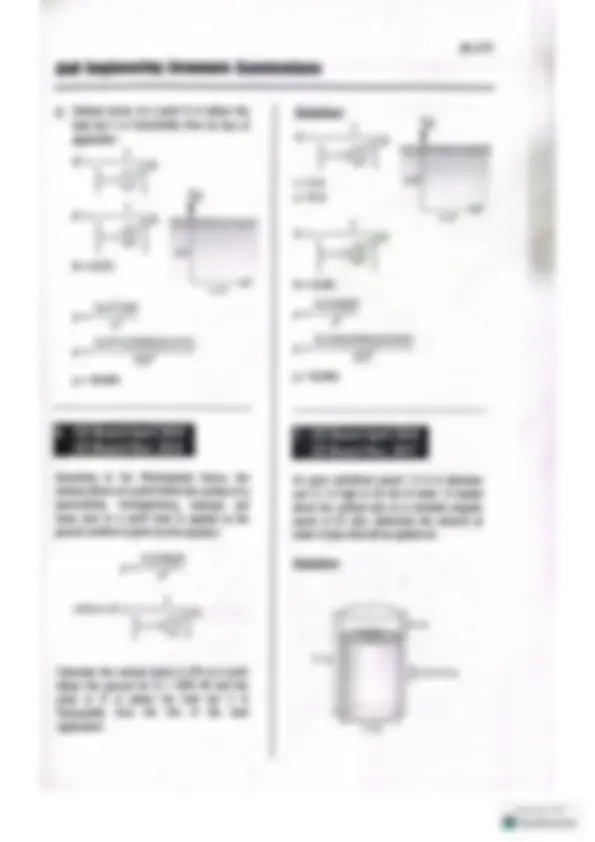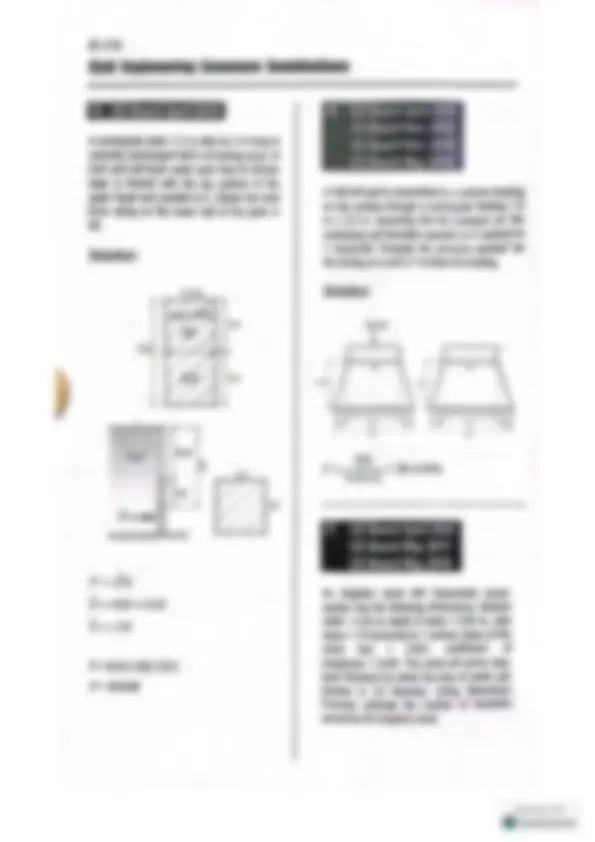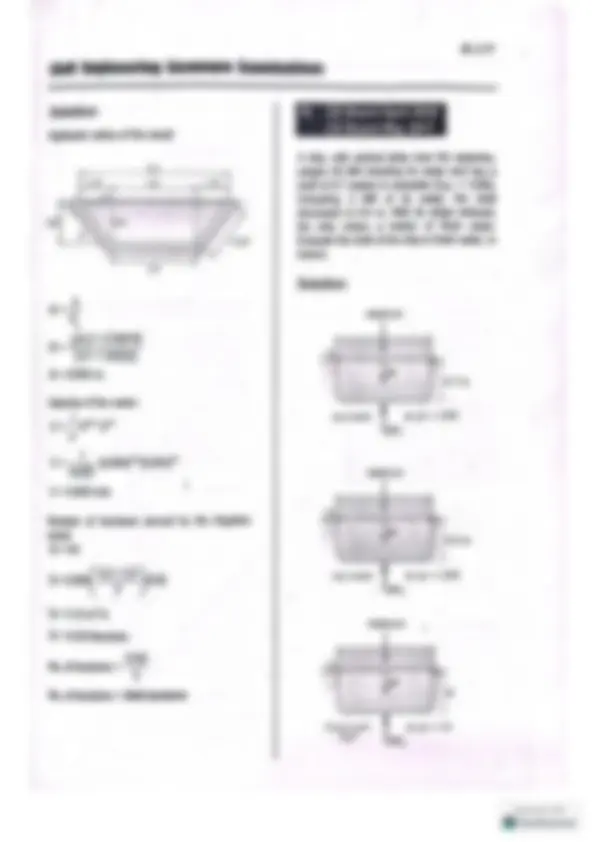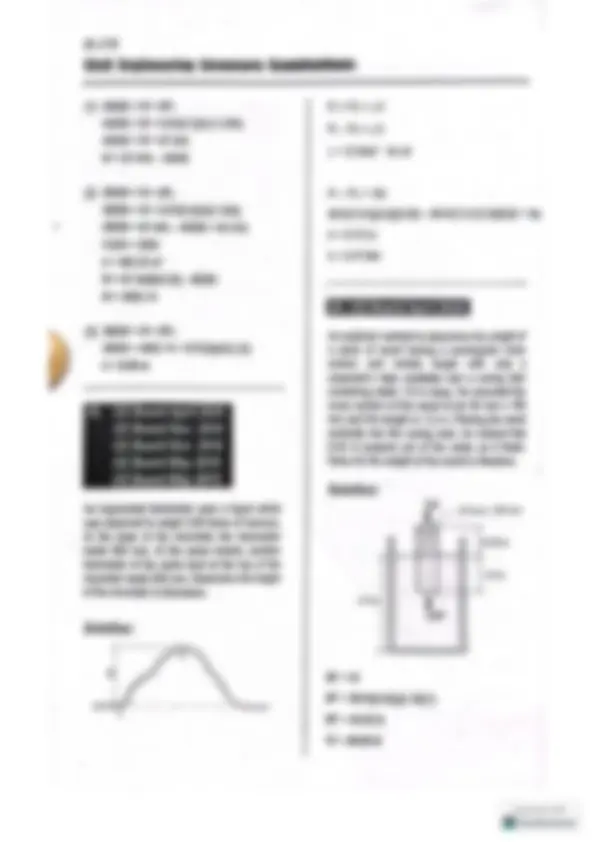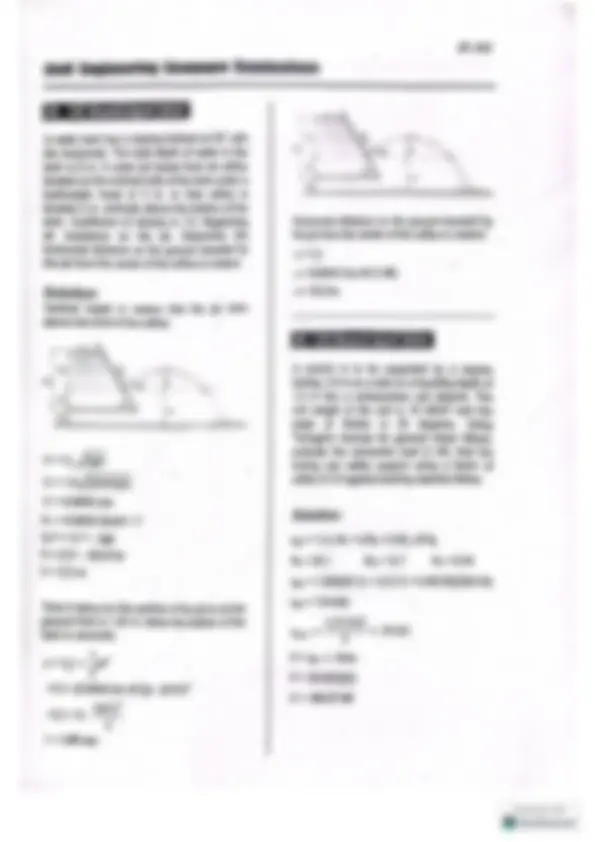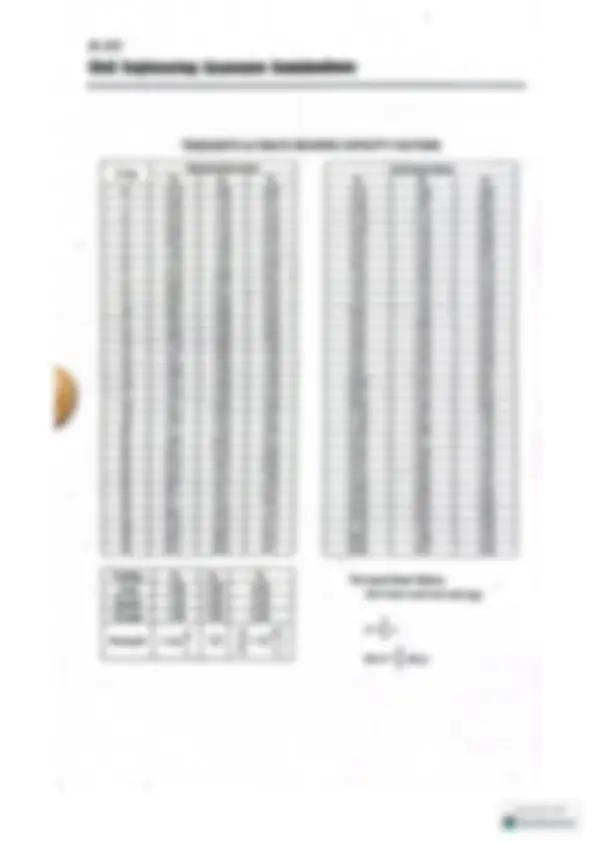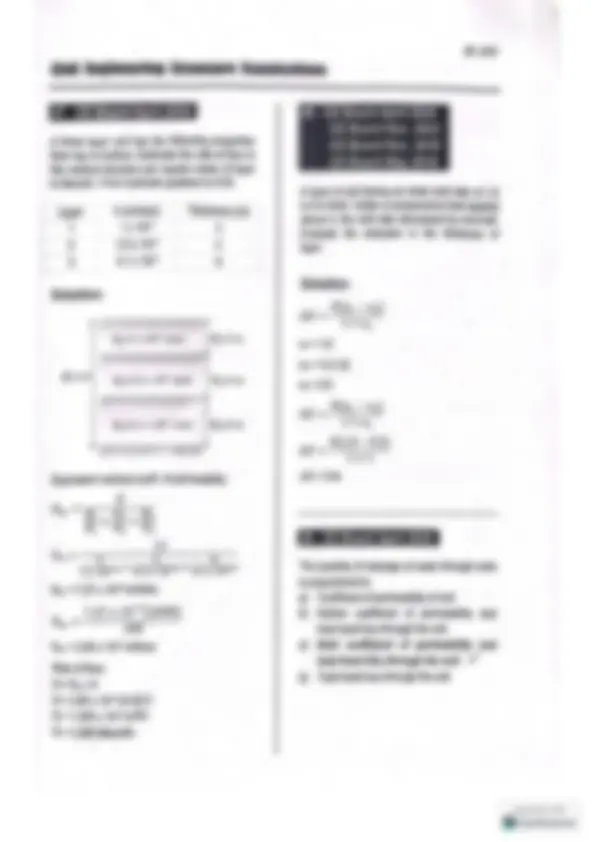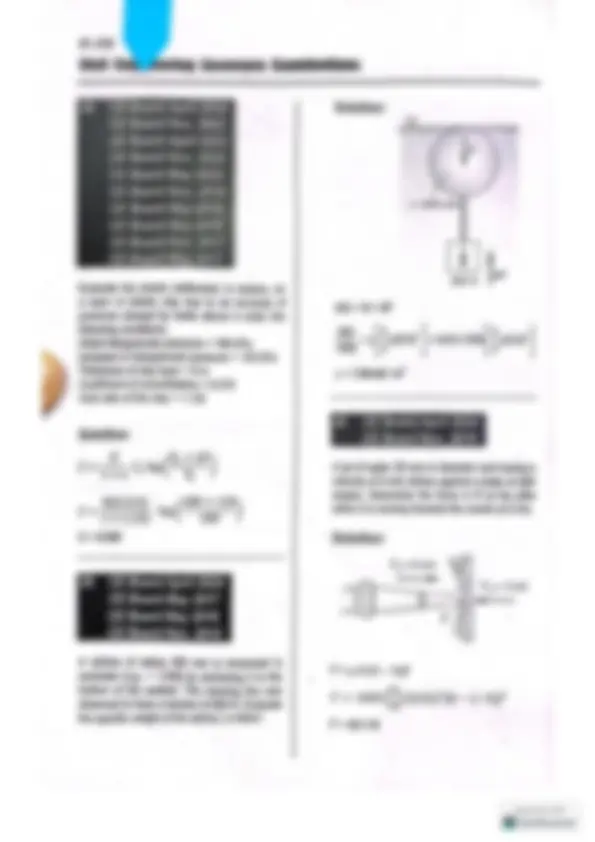Download Hydraulics and Geotechnical Engineering Exam Problems and more Exams Civil Engineering in PDF only on Docsity!
H-169 QUI ENCIETRING LICENSURE EXAMINATIONS ff HYDRAULICS and GEOTECHNICAL ENGINEERING APRIL 2024 1. CE Board April 2024 Solution: : CE Board April 2023 a) Effective pressure at the mid height of CE Board Nov. 2022 clay before lowering the water table CE Board May 2022 t Ses CE Board May 2019 Sand ' CE Board May 2018 i : 192m) gge2L2 Nim? CE Board Nov. 2017 1 dj 218.2 kim? . A layer of clay 7.6 m thick is overlain by a 38 deposit of sand 15.2 m ‘thick to ground 276m) Cl” ae + surface. When the water table is at ground 1 ai=18.8 KNim? 28 surface level, the saturated unit weight of the ' aa ene otros Sect sand was determined to be 21.2 kNim? for which its dry unit weight of 18.2 kN/m3. The oa= (21.2-9.81)(15.2) + (18.8 - 9.81)(3.8) saturated unit weight of the clay is 18.8 kN/m?. oa = 207.29 kPa When the ground water table lowered by 10 m, the degree of saturation of the sand above b) Effective soil pressure at mid-height of the water table was lowered to 20%. At the clay after lowering the water table by 10 m mid-height of the clay layer, capolae . —— a) determine the effective pressure, in kPa, 10 | (oa ea. before the lowering of the water table. water table b) determine the effective pressure, in kPa, ; az srs J , after lowering of the water table. a6 {: Clay ¥ sat oe kN/m3 bs ( ¢) determine the effective pressure, in kPa, : when there is no water in the sand layer cea OME oe but remain in moist condition at the same , (G,+e)%, degree of saturation. ‘oat = —T4e _G tery, eh teat "T4+e 1+e Scanned with H-170 Civil Engineering Licensure Examinations oy e(9.81) Vsat = Vary + 76 9.81e 1+e 21.2 = 18.2'+ - 981e “1te 3 +3e =9.8te e=0.44 G, hy Yay T4e G,(9.81) 1+0.44 Gs = 2.67 3= ‘Ywet Of sand with degree of saturation of 20%. pees (G, + Se)y, wet: 1+e _ [2.67 + 0.2(0.44)]9.81 Twee = 1+0.44 ‘Ywet = 18.79 kNim3 10 V wet =18.79 KN/m? water table 52 ggg =21-2 KN/m3 38| 1 sat =18.8 kN/m? jo —— e 38 A PaaS ea n= 18.79(10) + (21.2-9.81)(5.2) + (18.8 ~ 9,81)(3.8) n= 281,29 KPa c) Effective pressure when there is no water in the sand layer but remain in moist condition at the same degree of saturation t - ai Sand 15.2 et =18.79 KN/n? 3.8 16| Clay Ae meen caeen 9 Y gqt=18.8 KN/m> 38 i. io sh | oA = 18.79(15.2) + (18.8 — 9.81)(3.8) oa = 319.77 kPa 2. CE Board April 2024 The total weight of soil when fully saturated is 1600 g and the weight of the soil after drying is 1000 g. If the specific gravity of the soil grains is 2.67. a) Evaluate the moisture content in percent. b) Evaluate the void ratio. c) Evaluate the porosity. Solution: a) Moisture content nie 4 lary T+ 1000 = > 1+@ @ = 0.6 or 60% b) Void ratio _ 4,0 eet _ 2.67(60) Smee e= 1.60 s 100 Scanned with {3 CamScanner’: H-172 Civil Engineering Licensure Examinations b) Location of force from the center of gravity of the plate ext Ay A=n(0.3)2= 0.283 m2 y=23 Fa 7(0.6)* fd 64 ly = 0.00636 m4 ¢ = 0.00636 ~ 0.283(2.3) e= 0.00978 m e=9.78mm c) Location of force from the liquid surface D=h+e D=2.3 + 0.00978 D= 2.30978 D = 2309.78 mm D=2310mm 5. CE Board April 2024 CE Board Nov. 2016 According to the Boussinesq's theory, the vertical stress at a point below the surface of a semi-infinite, homogeneous, isotropic soil mass due to a point load Q applied at the ground surface is given by the equation: _ 0.477QN =—5 N=——— [+O] Evaluate the vertical stress in kPa at a point below the ground for Q = 2500 kN. a) if the point is 3 m directly below the point of application of the load. b) if the point is 6 m directly below the point of application of the load. c) if the point is 6 m below the load but 3 m horizontally from its line of application. Solution: a) Vertical stress at a point 3 m directly below the point of application of the load 1 Nis y27e5 F +() | 4 Nea +025 N=1 0.477QN p= 52 _ 0.477(2500)(1) Bele p= 132.5 kPa b) Vertical stress at a point 6 m directly . below the point of application of the load 0.477QN t Samoa c 0.477(2500)((1) 2 (6)? p=33.1 kPa Scanned with {3 CamScanner’: Civil Engineering Licensure Examinations c) Vertical stress at a point 6 m below the load but 3 m horizontally from its line of application “POT Q 1 N= 25 4 : - 3 ' : [+@| a N=0.572 LE Sp r=. 0.477QN Bs Ze _ 0.477(2500) (0.572) a (6)? p=19 kPa 6. CE Board April 2024 CE Board Nov. 2023 According to the Westergaard theory, the vertical stress at a point below the surface of a semi-infinite, homogeneous, isotropic soil mass due to a point load Q applied at the ground surface is given by the equation: 0.318QN P= where N = 7G [2 £2 ()| Calculate the vertical stress in kPa at a point below the ground for Q = 2500 KN and the point is 6 m below the load but 3 m horizontally from the line of the load application. Solution: i Q r=3m 26 z=6m | 1 TESTE CR : | [+2@)] | N= 0.544 _ 0.318QN B= Zz 0.318(2500)(0.544) % (Ou N= p=12kPa 7. CE Board April 2024 CE Board Nov. 2017 An open cylindrical vessel 1.3 m in diameter and 2.1 m high is-2/3 full of water. If rotated about the vertical axis at a constant angular speed of 87 rpm, determine the amount of water in liters that will be spilled out. Solution: 2 a.neld ze. =1.4m Scanned with H-175 Civil Engineering Licensure Examinations 10. CE Board April 2024 A granular soil ‘deposit is considered loose if the blow count of a standard penetration test is between: Solution: Relative Density of Sands According to Results of Standard Penetration Test SPT N-value Relative Density 0-4 Very loose 4-10 Loose 10-30 Medium 30-50 Dense Over 50 Very dense The blow count of a standard penetration test for loose soil is between 4 to 10. 11._CE Board April 2024 A sample of saturated soil has 30% water content and the specific gravity of the soil grains is 2.6. Determine the dry density of the soil mass in g/cm?, Solution: 5 = 2% e 100 = 30(2.6) e e=0.78 x Gs %y lary The 7, - 280) ary 1+0.78 ‘Yory = 1.46 gr/em? 12. CE Board April 2024 The admixture of coarser particles like sand and silt to clay causes: a) Decrease in both liquid limit and plasticity index. ¥~ b) Decrease in liquid limit and increase in plasticity index. c) Increase in both liquid limit and plasticity index. d) Decrease in liquid limit and no change in plasticity index. 13. CE Board April 2024 The shear strength of a cohesion soil is: a) ‘Inversely proportional to the angle of shearing resistance. b). None of the given choices. c) Proportional to the angle of shearing stress, d) Proportional to the tangent of the angle of shearing resistance. ~~ 14. CE Board April 2024 Water flows at 20 liters/sec. through 500 m of 150 mm diameter pipeline having a coefficient of friction of 0.02, Calculate the head loss for that length of pipeline. Solution: 0.0826 fLQ2 hy = ps h, = 2:9826(0.02) (500) (0.02)? Less (0.15)5 hr=4.35m Scanned with {3 CamScanner’: H-176 « Civil Engineering Licensure Examinations 15. CE Board April 2024 A rectangular plate 1.2 m wide by 2 m long is vertically submerged half in oil having sp.gr. of 0.84 and half fresh water such that its shorter edge is flushed with the top surface of the upper liquid and parallel to it. Obtain the total force acting on the lower half of the ‘plate in KN, Solution: 12m spgr-=0.64, lm Oil 2m HO Im 0.64 i Hy 12 05 EB 10 P—| P=y7hA h = 0.84 + 0.50 P=9.81(1.34)(1.2)(1) P= 15.8 KN 16.°CE Board April 2024 - CE'Board Nov. 2022. CE Board Nov. 2019; = CE‘Board May 2015* A 450 KN load is transmitted by a column footing on the surface through a rectangular footing 1.5 m x 2.5 m. Assuming that the pressure on the underlying soil formation spreads on 2 vertical to 1 horizontal. Evaluate the pressure exerted by the footing on a soil 2.7 m below the footing. Solution: 450 kN SLL Tat fist as, | 17. CE Board April 2024 CE Board May 2017 CE Board May 2016 An irrigation canal with trapezoidal cross- section has the following dimensions: Bottom width = 2.50 m, depth of water = 0.90 m, side slope-= 1.5 horizontal to 1 vertical, slope of the canal bed = 0.001, coefficient of Toughness = 0.025. The canal will serve clay- loam Riceland for which the duty of water per hectare is 3.0 liters/sec. Using Manning's Formula, estimate the number of hectares served by the irrigation canal. Scanned with {3 CamScanner’: H-178 Civil Engineering Licensure Examinations (1) 40000 + W= BF: 40000 + W = 9.81(6.7)(A) (1.026) 40000 + W = 67.444 W=67.44A - 40000 (2) 38000 + W= BFe 38000 + W=9.81(6.4)(A)(1.026) 38000 + 67.44A - 40000 = 64.424 3.02A = 2000 A= 662.25 m2 W = 67.44(662.25) - 40000 W = 4662.14 (3) 38000 + W=BFs 38000 + 4662.14 = 9.81(d)(622.25) d= 656m. 19. CE Board April 2024 CE Board Nov. 2019 CE Board Nov. 2018 CE Board May 2018 CE Board May 2015 An improvised barometer uses a liquid which was observed to weigh 0.80 times of mercury. _ At the base of the mountain the barometer reads 950 mm. At the same instant, another barometer of the same land at the top of the mountain’ reads 600 mm. Determine the height of the mountain in kilometers. Solution: pe h Py=Potyh Pi-Po=yh = 12N/m? for air P,-P2= 12h 9810(13.6)(0.8)(0.95) - 9810(13.6)(0.8)(0.6) = 12h h=3113m h=3.11 km 20. CE Board April 2024 An engineer wanted to determine the weight of a piece of wood having a rectangular cross section and certain length with only a carpenter's tape available and a curing tank containing water 1.8 m deep. He recorded the cross section of the wood to be 50 mm x 100 mm and the length is 1.5 m. Placing the wood vertically into the curing tank, he noticed that - 0.50 m projects out of the water as it floats. Solve for the weight of the wood in Newtons. Solution: ° {v—# mm x 100 mm T iG f] | 0.50m r ont ie 10m BF=W BF = 9810(0.05)(0,10)(1) BF = 49.05 N W=49.05N Scanned with H-179 Civil Engineering Licensure Examinations : 21. CE Board April 2024 _Avertical rectangular gate 1.5 m wide and 3 m high is hinged at the bottom with the shorter edge horizontal. On one side of the gate, water stands level with its top of the gate, on the other side, water stands 2 m. below the top. Evaluate the force applied horizontally at the top of the gate to open it. Solution:
6.04 2.59 10.90 3.36 0.88 19 15.6 6.70 3.07 11.36 3.61 1.03 20 17.7 7.44 3.64 11.85 3.88 1.42 21 18.9 8.26 4.31 12.37 + 447 5 1,35 22 20.3 9.19 5.09 42.92 4.48 1.55 23 21.8 10.2 6.00 13.51 4.82 1.74 24 23.4 11.4 7.08 14.14 + 5.20 1.97 v5 25.1 127 8.34 14.80 5.60 2.25 26 274 14.2 9.84 15.53 6.05 2.59 27 29.2 15.9 11.6 16.30 6.54 2.88 28 31.6 17.8 13.7 17.10 7.07 3.29 29 34.2 20.0 16.2 48.03 7.66 3.76 30 37.2 225 19.1 18.99 8.31 4.39 Fooling is if ! a For local shear failure: , ong Ht i . d and Square [130 | 1.00 040 (For loose san Soft clay) Circular 1:30 | 1.00 0,30 2 oFR 0 Rectangular | 14032 | 1.0 i -02 ®) 3 £ 2 L 2 tan @' = 3 lane Scanned with {3 CamScanner’: H-184 Civil Engineering Licensure Examinations 30. CE Board April 2024 CE Board May 2015 The unit weight of a liquid is variable and is given by the relation y = 12 + 0.5h, where y in kN/m? and h is the depth of the liquid from the surface in meters. Determine the gage pressure in kPa at a depth of 3 m. Solution: y=12+0.5h dP =ydh dP = (12 +0.5h) dh 2 0.5h P=12h+ > P = 12(3) +r P = 38,25 kPa 31. CE Board April 2024 A prism of dimensions 1.5 m x 1.0 m x 2.0m weighs 29.4 kN in water, determine its specific gravity. _ Solution: BF = (1.5)(1)(2)(sp.gr.)(9.81) 29.4 = 1.5(2)(9.81) sp.gr. sp.gr. = 1.0 32;\.CE Board April 2024 A soil has a bulk density of 2.3 g/cm? and water content 15%, determine the dry density of the sample. Solution: bulk density tary —“T oo 2.3 Yary T+ 0.15 ‘Yary = 2 gr/em? 33. CE Board April 2024 A layer of soft clay having an initial void ratio * of 1.0 is 9 m thick. Under a compressive load applied above it, the void ratio decreases by the fourth. Evaluate the reduction in the thickness of the clay layer in meters. Solution: _ H(e1 — e2) 1l+e, 1+1 AH = 3.375 m Scanned with {3 CamScanner’: H-185 . Civil Engineering Licensure Examinations 34. CE Board/April 2024 CE Board:Nov. 2015 The dry unit weight of a soil mass is obtained to be 15 kN/m*. If water is added to the soil mass so that the water (moisture) content is 25%, evaluate the unit weight of the soil in kNm’, ' Solution: __4 lary “T+ @ facil “1+ 0.25 y= 18.75 kNim? 15 35. CE Board April 2024 CE Board Nov. 2015 ) A3 m. diameter pipeline of length 2500 m. conveys water between reservoirs at the rate of 10 m/sec. What must be the difference in water surface elevation between the two reservoirs, in meters, neglect minor loss. Coefficient of friction is 0.018. Solution: a _ 0,0826f.0% a p, = £20826(0.018)(2500)(10)" y 2(9.81)(3)° h, = 1.53 m h 36. CE Board April 2024 CE Board Nov. 2021 The velocity head of the flow at one section is 5 m. Evaluate the velocity head in meters at the next section if the velocity of the flow increases by one-half that of the previous section. Solution: VF 2g 29 (154)? _ 2.25," 2gr 0s 29 (151)? _ les 2.25(5) = 11,25 37. CE Board April 2024 Water 2.4 m deep flows at a rate of 12 cu.m/sec in a trapezoidal channel 3 m at the base and 5 m wide at the water surface. Evaluate the discharge velocity in m/s. Solution: tf sm 24 “Rigo eee a 4 3m Q=AV 5 +3 125 CS) (24)v V=1.25 m/s 4 Scanned with 
